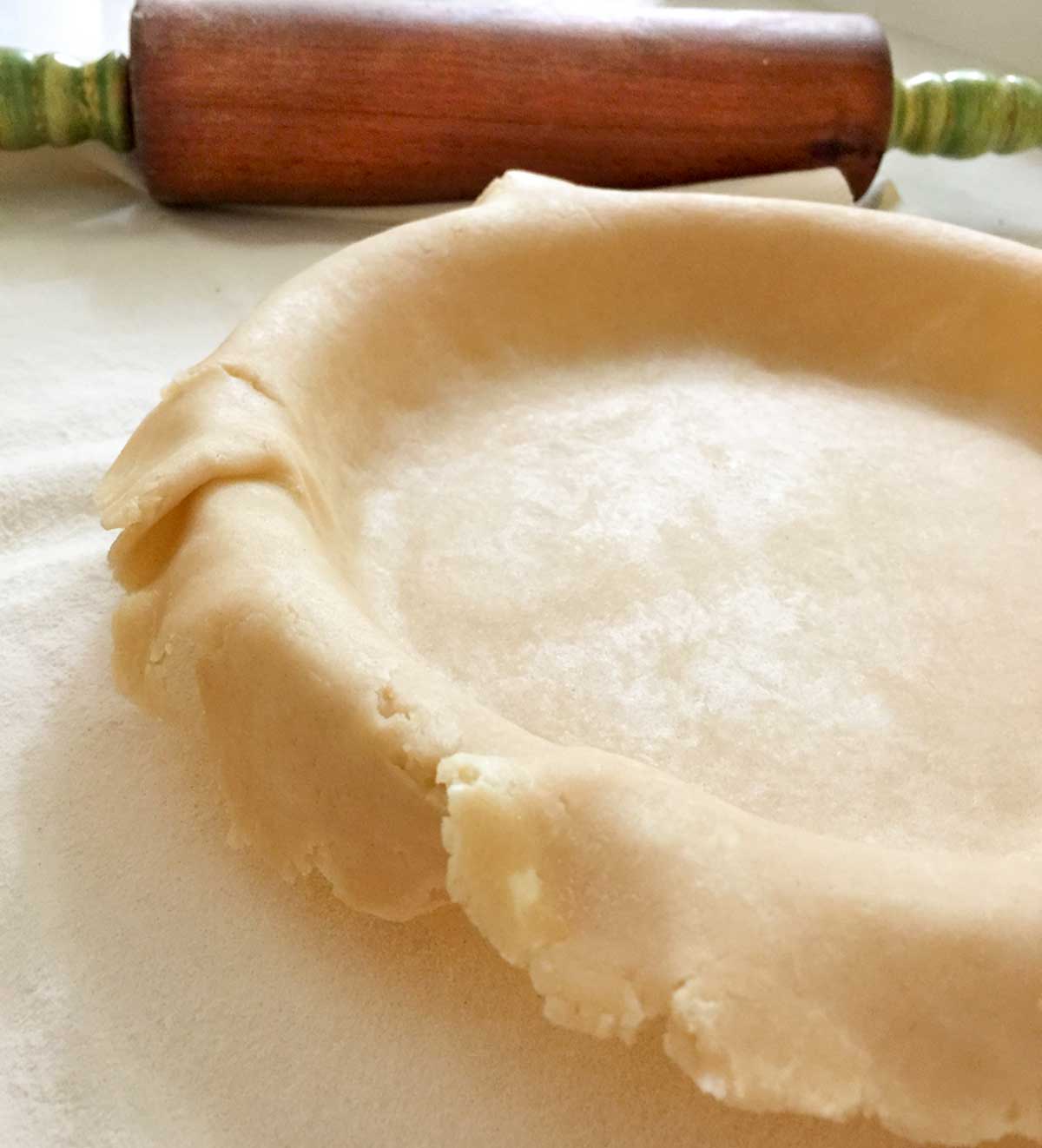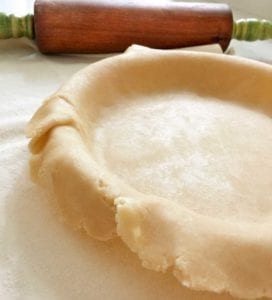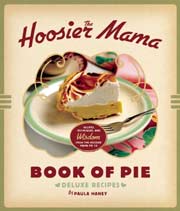
This is the most important recipe at the pie shop. It’s the secret to 90 percent of the pies we make, sweet and savory. New bakers aren’t considered full members of the team until they master it. [Editor’s Note: This pie crust is designed to be blind baked, which means it’s partially baked unfilled until golden brown. It’s not suitable for use in any recipe in which the crust is not blind baked. We suggest you try it with our sugar cream pie.]–Paula Haney

All-Butter Pie Crust
Ingredients
- 1 3/4 sticks (7 oz) unsalted butter
- 1 tablespoon red wine vinegar [Editor’s Note: Yes, red wine vinegar]
- 1/2 cup cold water
- 2 1/4 cups all-purpose flour, plus more for the work surface and the pan
- 2 1/4 teaspoons kosher salt
- 1 1/2 teaspoons granulated sugar
- Canola-based cooking spray, for the pan
Instructions
- Cut the butter into 1/2-inch cubes, setting apart 5 tablespoons. Freeze those 5 tablespoons for 20 minutes or up to overnight. Stash the remaining 9 tablespoons in the refrigerator until ready to use.
- Stir the red wine vinegar into the cold water.
- In the bowl of a food processor, combine the flour, salt, and sugar and pulse 5 or 6 times to combine.
- Add the 9 tablespoons butter and mix for 25 to 30 seconds, until the mixture resembles coarse meal.
- Add the frozen butter and pulse 15 to 20 times, until the mixture is in pea-size pieces.
- Add 6 tablespoons vinegar water and pulse 6 times. The dough should start to look crumbly. Test the dough by squeezing a small amount in the palm of your hand. If it easily holds together, it's done. If not, add 1/2 tablespoon vinegar water and pulse 3 more times. Repeat this process as needed until the dough holds together.
- Transfer the dough to a lightly floured work surface and gently knead just until smooth. Do not overwork the dough. It will still be a slightly shaggy mess.
- Divide the dough into 2 equal parts and roll each into a ball. Flatten the balls slightly and wrap separately in plastic wrap. Let the dough rest in the refrigerator until ready to use, at least 20 minutes but preferably overnight. (Once the dough is rested, it can remain in the refrigerator for up to 3 days or be frozen for up to 1 week.)
- To blind bake the pie, lightly coat a 9-inch pie pan with canola-based cooking spray and dust it with flour. Roll out the dough on a lightly floured surface to a circle larger than the pie pan. Transfer the dough to the pan and roll a rolling pin over the top of the pan, letting the excess dough fall away. Crimp the edges of the dough as desired. Freeze the pie shell until firm, about 30 minutes.
- Preheat the oven to 400ºF (200ºC).
- Place the frozen, crimped pie shell on a baking sheet. Line the inside of the shell with parchment paper or a coffee filter. Fill with uncooked beans or pie weights until the beans or weights are even with the top edge of the crimp. Press down to make sure they spread to the edges of the shell.
- Bake for 20 minutes, rotating the pie shell 180° halfway through the baking time. The outer edge of the crimp should be dry and golden brown.
- Remove the pie shell from the oven and carefully remove the parchment paper or coffee filter full of beans. If the paper sticks to the pie, bake it for 3 more minutes and try again. Once the parchment paper or coffee filter is removed, prick the bottom of the shell all over with a fork. Bake for 3 more minutes, until the interior of the shell is dry and light golden brown.
- Let cool to room temperature before filling with your choice of filling.

Explore More with AI
Nutrition
Nutrition information is automatically calculated, so should only be used as an approximation.
Recipe Testers’ Reviews
I have been working on my pastry skills for the past couple of years. I wanted to make this all-butter recipe as it used red wine vinegar (I always add vinegar to my pastry but have only used plain old white vinegar or cider vinegar). In addition, I always use pastry flour and this recipe uses all-purpose. So this recipe was an opportunity to try something new.
The pastry came together very easily. I find pastry needs very little kneading and, unlike bread making, over-kneading is not a good thing for pastry.The test of a great pastry comes with the results. I used this all-butter pastry for a beef and pork meat pie I like to make. I wanted to make something I knew the filling of very well, so I could test the pastry with that knowledge of the filling. The results…? I liked this pastry very much. It worked well with the savory meat pie filling. I will definitely make this one again.











I was watching Paula Haney’s YouTube video of this pie crust. I am confused about the size of the pie she is making. I thought the ingredient was for two 9″ double pie crusts. However, that dough-cutting thing she is using in the video is huge. And the pie tin doesn’t look like a 9″ pie tin, either. I don’t see the question being asked—am I the only one confused? What is approximate the size of the roll-out dough before put over the pie pan? Do you happen to know? Thanks!
Austin, based on what we’ve been able to find online, that dough cutter is 14 inches in diameter. Using that size gives plenty of extra dough for folding and crimping, as you can see in the video. I believe she is using a 9-inch pie pan there and the dough has been rolled out and cut to 14 inches.
Where can I find the large cutter with the handle that was used in the video for Chicago Tribune video on YouTube for this recipe?
Sherry, in the video she mentions having found it at a pizza supply store, so if you have one near you, that might be an option. If not, it looks like you can find a similar one here (Amazon).